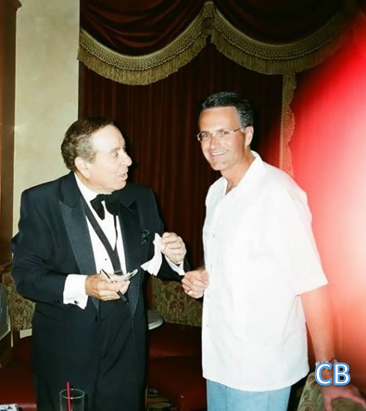Artist Spotlight
John Brim: An Unheralded Chicago Blues Legend
In many respects, it’s the classic American rags-to-riches story. Now, I’m moving forward a bit here to make my point, but in May, 1953 for the Fortune label, John Brim recorded a song that went on to be more widely known that I’m confident in saying he ever could have imagined. It was John Brim influencing rock and roll.
First, let me tell you another story.
Sam Butera, the musical genius behind Louis Prima’s famed Las Vegas showroom band, The Witnesses, penned and arranged “Just A Gigolo / I Ain’t Got Nobody” while working with Prima. Butera wrote many cocktail lounge swinging standards that have stood the test of time. David Lee Roth, the long-time wild front man of rock supergroup, Van Halen, took Butera’s song to the masses via his 1985 solo EP, Crazy From The Heat. Roth wasn’t the only person or group to also cover the song, but by most accounts, he made a lot of money from it. The song was also covered by Los Lobos, Brian Setzer, The Village People, and Big Bad Voodoo Daddy.
In the early 2000s, I was in Las Vegas, and I made the trek one evening out to Summerlin to hear Butera, one of my musical heroes, play at a casino lounge. I don’t remember the resort’s name, but Butera put on a clinic of showmanship, high musical standards, and class. The lounge had a mix of older folks who would’ve remembered the golden days of Butera’s work with Prima, middle aged folks, hip young swing dancers replete in their period attire, and curious musical geeks like me, all wanting to see and hear the legendary Sam Butera in such an intimate setting.
Sam’s band was stylish in their matching tuxedos and highly-shined shoes, as was Butera in his one-step-up front man’s apparel. The reverence for Butera from his band members was obvious, and the deep burgundy motif of the lounge gave the overall proceedings a heavy touch of refinement. However, when Butera introduced “Just A Gigolo / I Ain’t Got Nobody” as the band’s next song in their show, there was an unveiled disgust leveled toward Roth, essentially indicating that he never got a dime from Roth from the use and huge success of his song. He also revealed that awhile back Roth approached him at one of his shows, and Butera told him to, “Go fuck yourself.” The cut was deep for Butera, and his disdain for not receiving due credit and monies he felt owed him was a wound obviously too deep to heal.
Like Butera’s situation, Brim’s 1953 tune would too reach unfathomable heights of familiarity and notoriety, ironically, again with a David Lee Roth connection. That 1953 Fortune label song that Brim recorded, “Ice Cream Man”, originally remained shelved until the Chess label released it in 1969, because prior to that time, the lyrics were considered too suggestive for airplay and public consumption. Lyrics such as, “Yes I’m your ice cream man, stop me when I’m passin’ by/I’m your ice cream man, stop me when I’m passin’ by/They say all my flavors are guaranteed to satisfy” and “Well, I’m usually passin’ by just about eleven o’clock/I’m usually passin’ by, just around eleven o’clock/And if you let me cool you one time, you’ll be my regular stop” certainly would’ve been found to be morally concerning in the early 1950s due to their sexual connotations. It’s a bit ironic, in that the blues if full of lyrical double entendre of the carnal nature.
Van Halen covered Brim’s “Ice Cream Man” on their debut 1978 album, Van Halen. The song was essentially word-for-word correct to Brim’s original, aside from a couple of exultations from Roth. The difference between Butera’s and Brim’s experiences was that Brim realized significant royalties in 1981 from the Van Halen usage of his song, enough so that when combined with royalties he also got from the J. Geils Band for the use of his “Be Careful What You Do”, he could open his own blues club on N. Broadway in Chicago (a place, by the way, where it was not uncommon to find Walter Horton and Floyd Jones on any given night). It also allowed Brim to open his own dry-cleaning shop, and a record store, as well. Brim had realized financial success not often seen in the blues circle. Brim’s music indeed influenced modern music.
But in between the typically challenging beginning of his blues career and the eventual monetary windfall, it was the prototypical blues journey for Brim.
By way of his Kentucky birthplace, Brim made his way to Indianapolis, Indiana in 1941 to pursue certain musical opportunities. He then made his way north to Chicago in 1947 to reunite with Homer Wilson, a bluesman he knew from his Indianapolis days. They played together in the evenings, while Brim worked in a dry-cleaning business during the day. The move to Chicago and evening gigs allowed Brim and Wilson to work with the highly-popular John Lee “Sonny Boy” Williamson. As Brim and Wilson expanded the footprint of their playing opportunities, one of the cities they performed in was Gary, Indiana. It was in Gary where Brim would meet a young woman named Grace, and he would take her as his wife, and eventually, his musical partner with Wilson.
To offer support to Brim and Wilson, Grace would learn the harmonica and drums, becoming quite proficient on both. An encounter with Big Maceo in Chicago after Maceo had suffered his debilitating stroke offered the opportunity for Brim and Grace to play with him. They also joined Maceo in Detroit to participate on his last recording session.
The call for the talents of the Brims were increasing, and they offered their support behind other blues piano artists including Sunnyland Slim and Roosevelt Sykes, and they were also tapped by Little Walter and Jimmy Reed to back them. Their collective talents were being noticed.
Between 1950-1953, John Brim recorded and released 22 cuts for a variety of labels including Fortune, Random, J.O.B., Flyright, Juke Joint, Checker, Blue Horizon, and Parrot. On some of these cuts, Grace provided vocal work. Interestingly, in support on these recordings are the familiar names of Chicago blues greats including Big Maceo, Roosevelt Sykes, Moody Jones, Sunnyland Slim, Eddie Taylor, Ernest Cobb, Snooky Pryor, Big Crawford, Little Walter, Dave Myers, Louis Myers, Robert Jr. Lockwood, Elgin Edmonds, and Jimmy Reed, among others.
However, Brim’s career with the Chess (Checker) label seemed doomed. His fine blues, “Rattlesnake” a great blues that included Robert Jr. Lockwood on guitar, the mighty Fred Below on drums, and the legendary Willie Dixon on bass, never saw the light of day at the time because of impending legal action threatened by Duke-Peacock Records label owner, Don Robey, due to the song’s supposed familiarity to Big Mama Thornton’s “Hound Dog”. Brim never achieved any real traction with Chess, though his recordings for the label were solid efforts.
Brim’s blues was distilled during that fertile early 1950s period in Chicago when the music transformed from the country blues brought north by blacks new to the city, into the rugged amplified sort necessitated by the fermentation the music was experiencing in the loud taverns and bars of the south and west sides. The amplification was a conversion of the music from a softer delivery and expression of the black experience into the wildly noisier form predicated on the city and the experiences thereof of its black residents. The taverns and bars were loud environments, and the blues had to be loud to be heard. It was that period when the modern Chicago blues sound was created; the loud, boisterous brand of Chicago blues was exploding.
Many of Brim’s songs should have been, in my opinion, blues hits. Certainly, 1953’s “Gary Stomp”, a vibrant instrumental with its propulsive drive backed by Jimmy Reed’s great harmonica work, and Eddie Taylor’s guitar, had that danceable aura that made Little Walter’s “Juke” the success it was. The 1953 pragmatic tale of life’s difficulties, “Tough Times”, seems an ideal mechanism to relay and share the Chicago urban black life experience of the period. 1953’s “Rattlesnake”, a cut that includes the mood-setting harmonica work of Little Walter (including a strong instrumental break), tells the tale of a love gone bad, and surely would have resonated with the masses (the legal action previously mentioned destined this song to initial obscurity). After all, that is a recurring theme in the best of blues songs. And, “Be Careful What You Do” is a dynamic expression of a man cautioning his love interest about her actions, warning of the consequences of her attitude. From 1953, with Little Walter, Robert Jr. Lockwood, Willie Dixon, and Fred Below, this is Chicago blues of the highest order, and it stands tall against releases from other blues artists of the period. In so many ways, it feels as if the blues’ audience of the period just didn’t embrace Brim as it should have. Perhaps there were too many other “top-tier” blues artists in Chicago for the record-buying public to absorb one more.
Brim’s guitar was not flashy or in-your-face, but it provided the perfect backdrop for his blues, sympathetic yet confident, assured yet unassuming, simply providing the idyllic framework for the blues being recorded.
In the early 1960s, Brim abandoned his blues career, and settled into life in Gary. It wasn’t until the mid-1970s that Brim would again perform publicly, then appearing at various Chicago festivals.
Brim would be rediscovered by the broader blues community in 1989. Because of his rebirth, he would record for the Wolf, Tone Cool, and Anna Bea labels, with the 2000 Anna Bea collection being his final outing. Brim toured during the period 1998-2003, with a notable 2002 appearance at the Chicago Blues Festival being one the highlights. Renowned bluesman and acquaintance of mine, Billy Flynn, toured with Brim during this later period of his career, and had high respect for Brim’s achievements and abilities. Unfortunately, during this later career time period, Brim’s wife of 52 years, Grace, passed away.
I don’t remember the exact year, but it was in the early 1990s, and Brim was invited to attend an event honoring him here in the South Bend, Indiana area. He showed-up to the event immaculately dressed, was very appreciative of the distinction being bestowed upon him, and he played and sounded tremendous in-performance with a local band. It was one of those times when I was almost star-struck when I introduced myself to him, as my reverence for him as a pioneer of Chicago blues was great. He was gracious to me, and I look back at that evening with great fondness.
If you do not have any John Brim in your blues collection, you need it. You need to start with an overview comprised of his 1950-1953 era recordings. Then, compare them to the output of other Chicago blues greats of the period. I believe you’ll agree that John Brim never achieved the stature he should have enjoyed. Brim and his blues remain, in my assessment, outstanding treasures of Chicago blues, with Brim being someone deserving of much higher prominence. His music is on par with anyone recording during the early-to-mid 1950s period in Chicago.
Within Brim’s blues, you’ll find just what the blues means.


